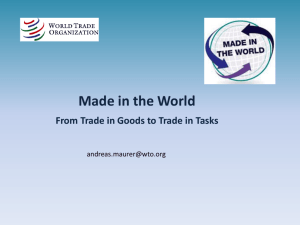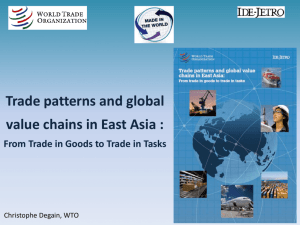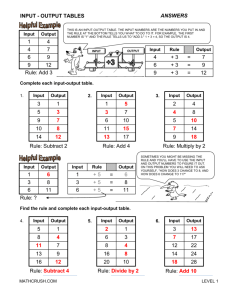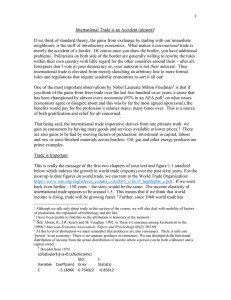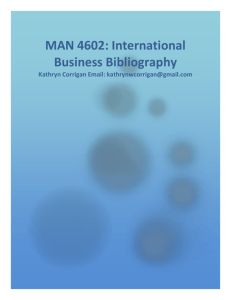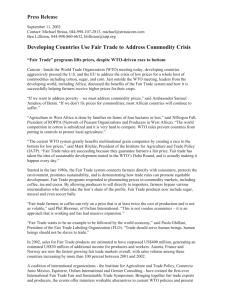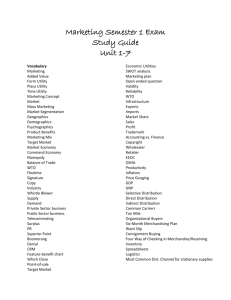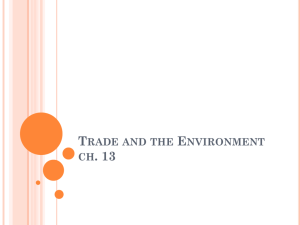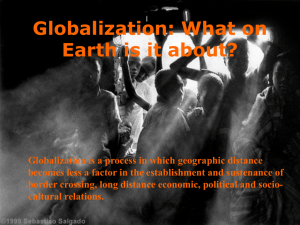Trade in value added
advertisement
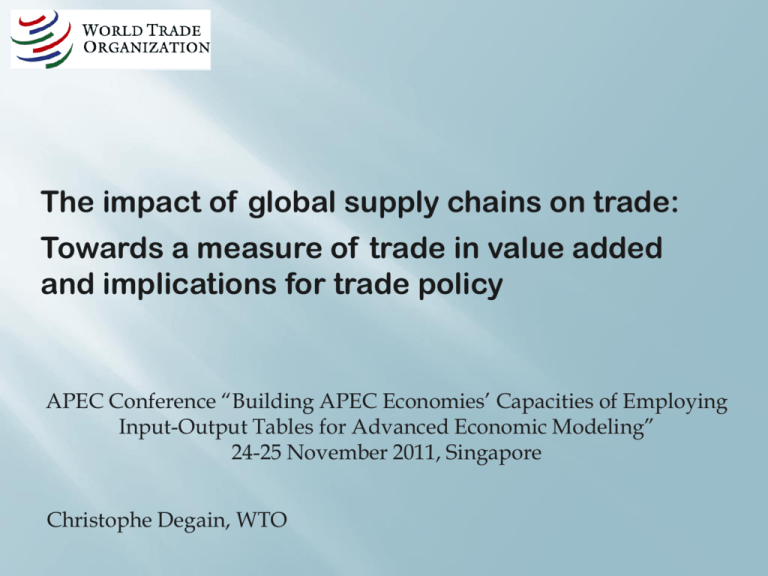
The impact of global supply chains on trade: Towards a measure of trade in value added and implications for trade policy APEC Conference “Building APEC Economies’ Capacities of Employing Input-Output Tables for Advanced Economic Modeling” 24-25 November 2011, Singapore Christophe Degain, WTO International consumer demand Emergence of “Trade in tasks”: Lower applied tariffs and trade policy incentives Development of infrastructure and technological progress Global supply chains and world trade Export processing zones Outsourcing and offshoring strategies and Foreign Direct Investment (FDI) • Increase of processing trade • Predominance of trade in intermediate goods • Development of intrafirm trade Need for new statistical measures of international trade Use and impact for trade analysis and policy economies with EPZs (2006 or most recent year) Sources: ILO and WTO Billions of US$ 2009 value Sources: UNSD and WTO US exports of private services, 1999-2010 (Millions of US$) Source: US BOP Traditional trade statistics present some biases: • Multiple counting of trade flows in intermediate goods and services • Difficult attribution of the country of origin of an imported product Using I-O tables and measuring trade in value added terms allows: • To circumvent the biases observed with traditional statistics • To take into account the specificity of trade occurring between the different actors of a production chain • To decompose the value added of exports into its domestic and foreign contents Source: Meng and Miroudot Added Value Customer services Standardization Innovation Brand R&D Marketing Design Logistics Manufacture Services Assembly Goods and services Services Manufacturing process Source: WTO, based on Shih S. , Business Week (May 16, 2005) Source: Meng and Miroudot, based on Xing and Detert (2010) Some evidence on the interdependency of economies within GVCs : • Exports of manufactured goods rely on imported inputs (goods and services) • Domestic VA is present not only in exports but also in imports (“Circular trade”) • So called “national products” may be predominantly produced in other countries, while products of foreign trademarks may be manufactured in the domestic market Protectionist measures … • Tariffs increase • Anti-dumping measure • “Buying national” engagement … can have counter-productive effects on economies and enterprises they are supposed to protect: • Reduction of the capacity of national firms to join GVCs • An increase of the cost of imported inputs affects national companies involved in international production chains, as well as the functioning or competitiveness of the chain itself ! Source: Diakantoni and Escaith, WTO (forthcoming 2012). Preliminary data, based on WTO tariffs and IDE-JETRO input-output databases Sectoral transmission of a supply-driven shock emanating from the Japanese industries (selected countries and sectors, 2008) b China Indonesia Korea Malaysia Philippines Chinese Taipei Thailand USA Average (all economies) Chemical products 0.7 0.3 2.2 2.1 1.0 3.2 1.0 0.3 1.4 Petroleum and petro products 0.1 0.0 0.0 0.7 0.3 0.1 0.0 0.1 0.3 Rubber products 0.6 0.6 1.7 1.1 1.2 2.6 1.3 0.4 1.3 Non-metallic mineral products 0.5 0.4 0.8 1.3 0.7 1.2 1.2 0.2 0.9 Metals and metal products 1.0 1.4 2.8 4.5 2.2 3.6 2.7 0.4 2.4 Industrial machinery 1.4 4.9 2.9 3.1 2.3 5.0 7.5 0.6 3.5 Computers and electronic equipment 3.6 1.5 3.0 4.3 7.4 5.6 5.7 0.8 3.9 Other electrical equipment 2.3 1.4 3.0 4.3 1.9 5.2 6.3 0.6 3.2 Transport equipment 1.4 1.6 2.9 3.8 2.1 3.4 5.8 1.0 2.8 Other manufacturing products 0.9 1.0 2.7 2.4 1.2 4.2 1.7 0.4 1.8 1.2 1.3 2.2 2.8 2.0 3.4 3.3 0.5 2.2 Supply shock from Japan to: Average (all sectors) b a Notes: a/ Percentage increase in sectoral domestic production costs resulting from a 30 per cent raise in the price of intermediate inputs imported from Japan. Results higher than 2% are highlighted in red. b/ Simple average. Source: adapted from Escaith and Gonguet, (2011), based on IDE-JETRO Asian Input-Output tables. • Comparative advantage: trade in value added reveals that comparative advantage applies more to tasks than to final goods • Trade and employment: the value added approach is relevant to estimate the “job content” of trade • Trade and environment: I-O tables can help estimating countries’ CO2 emissions associated with trade and their potential impact on climate change • Exchange rate policy: lower impact of currency revaluation on rebalancing trade imbalances Developing and improving the statistical tools used for trade in value added analysis • Development of standardised National Input-Output tables • Compilation of International Input-Output tables • Improving trade statistics: firm-level data, Services statistics Trade in value added • Towards an internationally agreed methodology and the production of trade in value added indicators to assist trade policy • Going beyond trade in value added: an income-based approach -----------------------------------The WTO Made In the World Initiative (MIWI) at http://www.wto.org/miwi A place for discussion and sharing of experiences and information (working papers, publications,…) on trade in value added for statistical issues and trade policy matters Contact and questions: christophe.degain@wto.org
